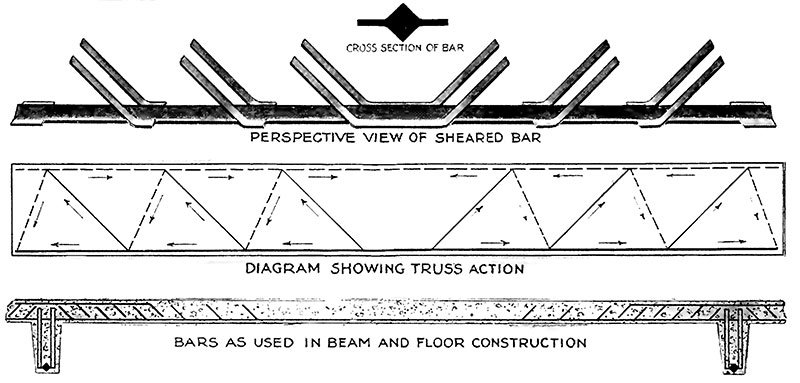The Kahn Bar: The Innovation That Reinforced the Future
The early 20th century was an era of rapid industrial expansion, calling for robust structures capable of supporting large, open spaces and heavy equipment. Concrete, though durable, was prone to cracking under stress—a significant limitation for high-stakes building projects. Julius Kahn, an inventive engineer and the brother to our company’s founder, Albert Kahn, saw this challenge as an opportunity. Enter the Kahn Bar, an innovation that would redefine the potential of concrete and change the trajectory of modern construction.
What Is the Kahn Bar?
At its core, the Kahn Bar is a reinforcement bar, or “rebar,” specially designed to strengthen concrete structures. Unlike typical smooth rebars, the Kahn Bar features angled flanges—wing-like projections along its sides—set precisely at 45 degrees. This unique design wasn’t just aesthetic; the angle and shape of the flanges allowed the bar to grip the surrounding concrete much more effectively than smooth steel could. These 45-degree wings enabled the concrete to spread forces evenly, making structures less prone to cracking and failure.
This reimagined rebar allowed buildings to incorporate larger, open spans without columns—a revolutionary change in architecture at the time. Factories and warehouses no longer needed dense forest-like arrangements of support columns, transforming the possibilities for interior design. For manufacturing and industrial spaces, this openness was critical, making room for large machinery and allowing efficient flow for workers and materials. The Kahn Bar turned concrete, a material previously limited by its rigidity, into something almost organic, responsive, and adaptable to new design possibilities.
The Ingenuity Behind the Kahn Bar
The genius of the Kahn Bar lies in its ingenious blend of simplicity and functionality. Julius Kahn’s 45-degree angle choice wasn’t arbitrary; it was an engineering insight grounded in physics. By setting the flanges at this angle, Kahn maximized the tensile strength within the concrete. The flanges acted as miniature anchors, locking the steel bar in place within the concrete and providing enhanced durability. This ingenuity meant that the Kahn Bar didn’t just reinforce concrete; it transformed it into a material capable of withstanding greater stress without compromise.
This simple yet powerful invention embodies Albert Kahn’s core value of ingenuity, pioneering an approach to problem-solving that was groundbreaking for its time. The Kahn Bar allowed architects and engineers to do more than simply reinforce structures; it let them create spaces that were previously thought impossible, setting the stage for the vast, open workspaces that would become hallmarks of modern architecture.
Curiosity Drives Innovation
Julius Kahn’s curiosity fueled the development of the Kahn Bar. Faced with the limitations of concrete, he saw an opportunity to explore new territory, questioning the constraints that architects and engineers had accepted for years. What if concrete could be made to work like steel? What if a rebar could enhance, rather than limit, design possibilities?
Kahn’s curiosity wasn’t just about engineering; it was about rethinking relationships between materials, architecture, and functionality. The 45-degree flanges were born from his desire to imagine a better way—a small detail that revolutionized how buildings could be constructed. Curiosity was the catalyst, pushing Kahn to experiment, rethink, and ultimately redefine the role of materials in design. This spirit of curiosity lives on today, reminding us that great design isn’t just about solving known problems but about asking questions that lead to unexpected breakthroughs.
Belonging: Building Spaces for People
The Kahn Bar didn’t just change buildings; it changed the lives of the people who worked in them. By enabling expansive, column-free spaces, the Kahn Bar allowed factories, warehouses, and offices to be open, airy, and efficient. For industrial workers, this meant better lighting, improved ventilation, and safer, more organized work environments. The open-plan factory layout became a symbol of modern industry, promoting productivity and innovation by giving people the space to move, collaborate, and belong in ways that were unheard of at the time.
This focus on creating environments where people could work more effectively speaks to the core value of belonging. The Kahn Bar wasn’t just a tool for building stronger structures; it was a means to build more inclusive spaces, where form and function worked hand in hand to support the needs of those within. In today’s world, this value of belonging remains just as relevant, guiding architects and designers to create spaces that consider the well-being and experience of every occupant.
Why Does It Matter Now?
It’s easy to relegate the Kahn Bar to the history books, yet its impact is still very much alive. Walk through any modern building, and you’re experiencing the legacy of that original invention. The Kahn Bar was a precursor to modern sustainable construction, proving that small innovations can lead to significant, enduring change. It reminds us that today’s challenges are tomorrow’s breakthroughs, sparking excitement for what comes next.
As we reflect on the Kahn Bar, it stands as a testament to the power of ingenuity, a reminder that curiosity can redefine our world, and proof that belonging is foundational—not just to the structures we build but to the lives they support. The Kahn Bar is more than a piece of history; it’s a symbol of the transformative impact that thoughtful design can have on our built environment, and it continues to inspire innovation today.


